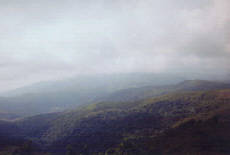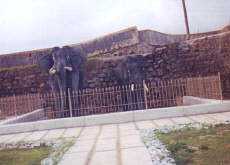Folk Tales from the Scotland of India
Coorg & Bangalore


Mist-covered hills of Coorg.
![]()
![]()
Tracking Down the Cauvery
The best way to begin for an impatient soul like me was to head first to its very source – Talakaveri, situated atop the Brahmagiri Hills. Densely wooded forests, an odd cottage or two, kids selling coconuts and honey, an odd cyclist, cattle grazing by the roadside, were all I saw during the hour-long car ride. Fortunately for me, the hotel had provided a very skilled driver. Else it would be scary plunging down the steep hillside.
I had to take off my shoes and walk up the 400 odd stone steps (actually there did not seem to be so many steps), probably the flower seller was exaggerating, I found myself staring at a tank, and another smaller tank. It is here that the Cauvery River is said to have taken birth. And it is here that she is worshipped by followers of the Hindu faith.
The larger tank is used to take holy dips and even in the cold of the early morning, there were a few bathers, including the pujaris (priests of the temple). I did not dare disrupt their morning prayers and hence, I tried to get as much information as I could from the driver and every obliging flower seller.
There are several folktales relating to the birth of Cauvery River. One of my favorite is that sage Agastya converted his wife into water and stored her in a jug, while he went deep into the forest. A crow toppled this jug and the water just spilled out, bounding merrily, hiding and then reappearing and Cauvery was born. It is true that Cauvery disappears underground for some distance and then resurfaces.
I then proceeded to a place called Bhagamandala, realizing that I had actually passed it earlier on my way to Talakaveri. But then, as the car driver protested, I had stated that I wanted to see the source of the river first. Well, he was right.
Pilgrims actually begin their journey from Bhagamandala and then proceed to Talakaveri. This place, however, was a bit of a disappointment. The two tributaries of Cauvery River join here, but it was a mere trickle, as the monsoons (rainy season) had not yet commenced. In fact the devout were standing in not more than knee-deep water, and that too at the farthest end. Four temples stand here, dedicated to the Hindu gods, including the goddess of wealth, the enigmatic elephant god, Ganapathi.
Lunch was at a nearby restaurant, run by a husband and wife team. Hot idlis (rice pancakes) and chutney (sauce of coconut and green chillies) made a simple but delicious meal. And this time, I downed cups of authentic Coorg coffee. Strong and aromatic, just the way I like it.
Then, it was back to the hotel, to join my parents for a trip to a coffee plantation.


The elephants at Maikeri Fort.
![]()
![]()
A Carpet of Green
Accommodation in Coorg is also available in resorts in the midst of plantations. But even if you are staying in a hotel, chances are that the owner does own a plantation or knows of someone who does.
My parents had done some fact-finding. Mum, a retired botanist, was thrilled that the Government actually owns a plantation-cum-research center. So this is where we headed. It was quite far from Madikeri, somewhere near Siddapur road, but worth the drive. The only snag: when we reached the research center, it was shut. There was a public holiday, which had caught us unawares (after all, how can I remember public holidays, when my office grants a holiday only on the most important national days!).
A very obliging security officer let us have a dekho (peek) at the sprawling acres of land. And he was also quite knowledgeable, both about folklore and agricultural practices. It seems that coffee was introduced in India by Baba Budan, a Sufi saint (saints introduced Islam to India centuries ago). The saint had brought these seeds from the Arabian region. There is a shrine dedicated to the saint in the Chikmagalur district. Unfortunately, we did not have time drive down there. We also learnt that a Britisher named Jolly realized the commercial potential of cultivation and export of coffee. Jolly good fellow!
Coffee bushes require shade, and to provide such shade, tall trees are an integral part of any estate. And on these are found black pepper vines. The research center is cultivating 18 verities of pepper, one named Padmini, probably the name of the wife or daughter of the botanist concerned.
I also found, to my astonishment, that cardamom (delicately flavored seeds found in a small pod) fruits from the root. The flower is found at the very base of the plant, and it is here that it turns into the much-coveted pod. Scientists are busy conducting research to reduce the thickness of the pod and to ensure that there are more seeds in the pod. Good luck to them, I love my deserts sprinkled with cardamom powder.
Research is also on to cultivate hybrid plants. I wish we had got an opportunity to meet the researchers. The security guard mentioned that they hardly get any visitors. He sure seemed glad to see us.
The Last Day
Sunday came, a bit too soon. I had woken up at dawn and took a walk down the road – Convent Road. St Joseph’s school stands at the end of this road. And then, there was this valley, green and peaceful with hills rolling in front of it.
Stone steps led down to it, and I was soon joined by a brown pie dog with the most melting eyes I have every seen. Sharing my breakfast of rice chapattis (pancakes), a local delicacy, was a pleasure and we both took in the peaceful atmosphere.
Soon, there were children in this park. Playing cricket or cycling around, or romping with the dog – Scampi, whom I now understand is very much a part of the valley. I aptly named it Happy Valley, and spent as much time as possible taking in the scene and soon, very soon, it was time for the drive back to Bangalore.
There is so much more to see in Coorg, An island surrounded by the Cauvery River, Nisargadhama, is a popular picnic spot. A Buddhist monastery at Bylakuppe and also a wildlife sanctuary, the Nagarhole National Park that abounds with deer and elephants and an occasional tiger. I know I shall be back for more.
For now, I still remember Coorg. Standing in my balcony is a plant, Mimosapudika (or touch-me-not) gifted by one smiling lady who had seen me admire her garden.. This plant shuts its leaves when touched. I hope no one spoils the beauty of Coorg with tall characterless buildings and noisy discos and pubs. It is perfect as it is.
——–